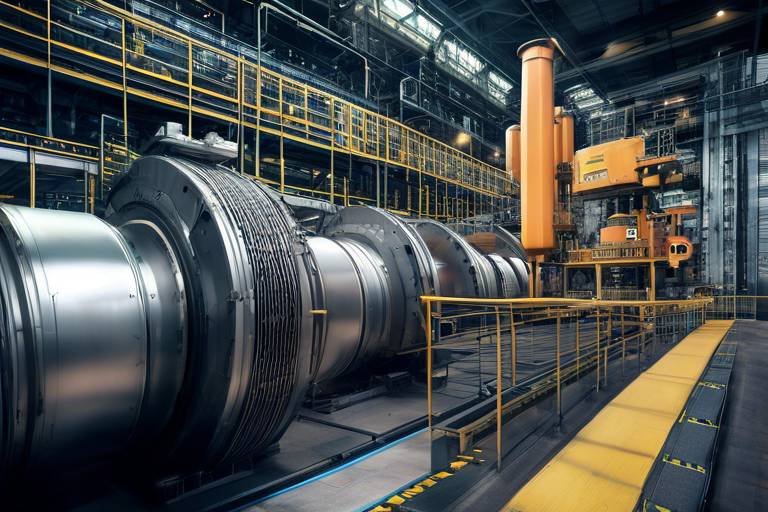AI and Predictive Maintenance in Industrial Facilities
In today's fast-paced industrial landscape, the integration of artificial intelligence (AI) into predictive maintenance is not just a trend; it's a revolution. Imagine a world where machines can communicate their health status, predict failures before they happen, and optimize their performance without human intervention. This is the promise of AI in predictive maintenance, a game-changer that transforms how industries operate and manage their assets. By harnessing the power of AI, facilities can not only enhance their operational efficiency but also significantly reduce downtime—a critical factor in maintaining productivity and profitability.
So, what exactly is predictive maintenance? At its core, it's about using data-driven insights to anticipate when equipment failures might occur, allowing for timely maintenance actions. This proactive approach contrasts sharply with traditional maintenance strategies, which often rely on scheduled maintenance or reactive measures after a failure has occurred. With AI, the process becomes smarter, more precise, and ultimately more cost-effective.
As we delve deeper into the impact of AI on predictive maintenance, we uncover a myriad of benefits that extend beyond mere cost savings. For instance, the ability to accurately predict equipment failures not only minimizes unplanned downtime but also enhances safety standards in the workplace. When machinery operates efficiently, the risk of accidents decreases, fostering a safer environment for all employees. Moreover, the longevity of equipment is significantly improved, leading to better resource management and capital expenditure.
However, the implementation of AI-driven predictive maintenance isn't without its challenges. Organizations must navigate the complexities of data integration from various sources, invest in the necessary technology, and ensure that their workforce is adequately trained to leverage these new tools effectively. Despite these hurdles, the potential rewards are immense, making it a worthwhile endeavor for any forward-thinking industrial facility.
As we look to the future, the landscape of predictive maintenance will continue to evolve, driven by advancements in AI and machine learning. The emergence of Industry 4.0 will further enhance these capabilities, creating a more interconnected and efficient industrial ecosystem. In this new era, real-time data-driven decision-making will become the norm, enabling industries to operate at unprecedented levels of efficiency and effectiveness.
- What is predictive maintenance? Predictive maintenance is a proactive maintenance strategy that uses data analysis to predict when equipment failures might occur, allowing for timely interventions.
- How does AI enhance predictive maintenance? AI analyzes vast amounts of data to identify patterns and predict equipment behavior, improving the accuracy and effectiveness of maintenance strategies.
- What are the main benefits of predictive maintenance? Key benefits include cost savings, improved equipment lifespan, reduced downtime, and enhanced safety in industrial operations.
- What challenges do organizations face when implementing predictive maintenance? Common challenges include data integration, technology costs, and the need for workforce training.
- What does the future hold for predictive maintenance? The future is promising, with advancements in AI and machine learning expected to refine predictive capabilities and enhance operational efficiencies.

The Role of AI in Predictive Maintenance
Artificial intelligence (AI) is revolutionizing the way industries approach maintenance, particularly through the lens of predictive maintenance. By harnessing the power of AI, organizations can analyze vast amounts of data to forecast potential equipment failures before they happen. This proactive approach allows for timely interventions, which are crucial in minimizing unplanned downtime. Imagine a scenario where a machine can "speak" to its operators, alerting them to issues long before they escalate into costly breakdowns. This is the essence of AI in predictive maintenance—transforming reactive strategies into proactive solutions.
One of the most significant advantages of using AI in predictive maintenance is its ability to process and analyze data at an unprecedented scale. Traditional maintenance methods often rely on scheduled inspections or reactive repairs, which can lead to inefficiencies and unexpected failures. In contrast, AI-driven predictive maintenance continuously monitors equipment health through various data inputs, such as temperature, vibration, and operational performance. By employing advanced algorithms, AI can identify patterns and anomalies that human operators might miss, providing insights that lead to better decision-making.
Furthermore, AI's role extends beyond just data analysis. It can also enhance the decision-making process by recommending optimal maintenance schedules based on real-time data. For instance, if a machine is showing signs of wear and tear, AI can suggest a maintenance window that minimizes disruption to operations while ensuring the equipment is serviced before a failure occurs. This level of foresight is akin to having a personal assistant who not only reminds you of your appointments but also predicts the best times to schedule them based on your availability and priorities.
To illustrate the impact of AI on predictive maintenance, consider the following table, which highlights the key elements involved:
| Element | Description |
|---|---|
| Data Collection | IoT sensors gather real-time data from machinery, providing a continuous stream of information. |
| Data Analysis | Machine learning algorithms analyze historical and real-time data to identify patterns and predict failures. |
| Decision Support | AI recommends maintenance actions based on predictive insights, optimizing operational efficiency. |
In addition to improving efficiency, AI-driven predictive maintenance enhances safety in industrial environments. By predicting failures, organizations can reduce the risk of accidents caused by equipment malfunctions. This is particularly important in high-stakes industries such as manufacturing, where the consequences of a breakdown can be severe, both in terms of human safety and financial loss. In essence, AI acts as a safety net, catching potential issues before they can lead to disaster.
Moreover, the integration of AI into predictive maintenance fosters a culture of continuous improvement. As organizations gather more data and refine their predictive models, they can develop a deeper understanding of their equipment's performance and longevity. This ongoing learning process not only helps in optimizing maintenance schedules but also contributes to better resource management and cost savings over time. It’s like having a gardener who learns the best times to water and prune plants based on weather patterns and soil conditions—ensuring that everything thrives.
In conclusion, the role of AI in predictive maintenance is transformative, enabling industries to shift from reactive to proactive maintenance strategies. By leveraging data analysis, enhancing decision-making processes, and improving safety, AI empowers organizations to optimize their operations effectively. As technology continues to evolve, the potential for AI to further enhance predictive maintenance practices is limitless, opening doors to smarter, more efficient industrial environments.

Benefits of Predictive Maintenance
Predictive maintenance is not just a buzzword; it's a game-changer for industrial facilities looking to enhance their operational efficiency. By leveraging advanced technologies and data analytics, businesses can unlock a treasure trove of benefits that significantly impact their bottom line. Imagine a world where machinery operates smoothly, failures are anticipated before they occur, and resources are allocated efficiently. This is the reality that predictive maintenance brings to the table.
One of the most compelling advantages of predictive maintenance is the potential for cost savings. By preventing unexpected equipment failures, companies can avoid the hefty price tags associated with emergency repairs and production downtimes. Instead of waiting for a machine to break down, organizations can schedule maintenance at optimal times, ensuring that resources are used effectively. This proactive approach not only saves money but also enhances the overall productivity of the operation.
Additionally, predictive maintenance contributes to an improved lifespan of equipment. Regular monitoring and timely interventions mean that machinery is kept in peak condition, which translates to better asset utilization. Think of it like taking your car for regular check-ups; just as a well-maintained vehicle lasts longer and performs better, so does industrial equipment that receives consistent attention. This leads to reduced capital expenditures on new machinery, allowing companies to invest in other critical areas of their operations.
Another key benefit lies in enhanced safety. By predicting potential failures, businesses can mitigate risks associated with equipment malfunctions, creating a safer work environment for employees. This proactive stance not only protects the workforce but also reduces liability for the organization. Safety should never be an afterthought; with predictive maintenance, it becomes an integral part of the operational strategy.
To summarize the benefits, consider the following table that highlights the key advantages of predictive maintenance:
| Benefit | Description |
|---|---|
| Cost Savings | Reduces expenses by preventing costly breakdowns and optimizing maintenance schedules. |
| Improved Equipment Lifespan | Regular maintenance extends the life of machinery, leading to better asset utilization. |
| Enhanced Safety | Predicting failures minimizes risks and creates a safer working environment. |
| Increased Operational Efficiency | Streamlined processes ensure machinery runs smoothly, improving overall productivity. |
In conclusion, the benefits of predictive maintenance are multifaceted and profound. By adopting this approach, industrial facilities can not only save costs but also enhance safety, improve equipment lifespan, and boost operational efficiency. It's like having a crystal ball that allows businesses to foresee potential issues and act before they escalate, ultimately leading to a more productive and profitable operation.
Here are some common questions regarding predictive maintenance:
- What is predictive maintenance? Predictive maintenance is a proactive maintenance strategy that uses data analysis and monitoring to predict equipment failures before they occur.
- How does predictive maintenance save costs? By preventing unexpected breakdowns and optimizing maintenance schedules, predictive maintenance reduces repair costs and minimizes downtime.
- What technologies are used in predictive maintenance? Technologies such as IoT sensors, machine learning algorithms, and data analytics tools are integral to predictive maintenance strategies.
- Is predictive maintenance suitable for all industries? While it is highly beneficial in many industries, the suitability of predictive maintenance depends on the specific operational context and equipment used.

Cost Savings
Implementing predictive maintenance is not just a trend; it's a game-changer for businesses looking to cut costs and improve their bottom line. Imagine having the ability to foresee equipment failures before they disrupt your operations. That's the magic of predictive maintenance! By using advanced analytics and real-time data, companies can significantly reduce the financial burden associated with unexpected breakdowns.
One of the primary ways predictive maintenance achieves cost savings is through the prevention of costly equipment failures. When machinery breaks down unexpectedly, it doesn't just lead to repair costs; it can also result in substantial downtime, which can be devastating for productivity. According to industry studies, unplanned downtime can cost manufacturers anywhere from $50,000 to $1 million per hour, depending on the type of facility and the machinery involved. By predicting when a machine is likely to fail, organizations can schedule maintenance during off-peak hours, allowing for smooth operations without the costly interruptions.
Furthermore, predictive maintenance optimizes maintenance schedules. Instead of following a rigid, time-based maintenance routine, businesses can tailor their maintenance efforts based on actual equipment condition. This not only helps in reducing the frequency of maintenance activities but also allows for better resource allocation. For instance, instead of having maintenance staff on standby for routine checks, they can focus on more critical tasks, enhancing overall productivity.
To put it into perspective, consider a manufacturing plant that spends $100,000 annually on maintenance. By implementing predictive maintenance, they could potentially reduce that cost by 30% to 50%—that's a savings of up to $50,000 a year! The advantages multiply when you consider the ripple effect on operational efficiency and resource management.
In addition to direct cost savings, predictive maintenance also leads to reduced repair costs. By addressing issues proactively, companies can manage repairs before they escalate into major problems. This approach not only saves money but also minimizes the need for emergency maintenance interventions, which tend to be much more expensive.
In summary, the cost savings associated with predictive maintenance are substantial. By preventing equipment failures, optimizing maintenance schedules, and reducing repair costs, businesses can allocate their resources more effectively. It's not just about saving money; it's about creating a sustainable, efficient operational environment that can adapt to the ever-changing demands of the industry.
- What is predictive maintenance? Predictive maintenance is a proactive maintenance strategy that uses data analysis and monitoring tools to predict when equipment failures might occur, allowing for timely interventions.
- How does predictive maintenance save costs? It reduces unplanned downtime, optimizes maintenance schedules, and minimizes repair costs by addressing issues before they escalate.
- What technologies are involved in predictive maintenance? Technologies like IoT sensors, machine learning algorithms, and data analytics tools are essential for implementing predictive maintenance strategies.
- Is predictive maintenance suitable for all industries? While it is particularly beneficial in manufacturing, predictive maintenance can be applied in various industries where equipment reliability is crucial.

Reduced Repair Costs
One of the most compelling advantages of implementing predictive maintenance in industrial settings is the significant reduction in repair costs. Think about it: when machinery breaks down unexpectedly, the financial implications can be staggering. Not only do you have to deal with the immediate costs of repairs, but there are also hidden expenses associated with lost productivity, emergency maintenance, and potential damage to other equipment. By utilizing predictive maintenance strategies, companies can proactively address issues before they escalate into major failures.
Imagine a scenario where a factory's conveyor belt is showing signs of wear. Without predictive maintenance, this issue might go unnoticed until the belt snaps, halting production and requiring extensive repairs. However, with the right monitoring systems in place, the wear can be detected early, allowing for timely interventions. This proactive approach results in:
- Lower Repair Costs: Addressing minor issues before they become major problems saves money on extensive repairs.
- Minimized Emergency Maintenance: Fewer unexpected breakdowns mean less need for costly emergency maintenance services, which often come with premium pricing.
- Improved Budget Allocation: With a clear understanding of maintenance needs, companies can allocate their budgets more effectively, ensuring funds are available for planned maintenance rather than scrambling to cover unexpected costs.
Additionally, predictive maintenance allows for more strategic planning of repair schedules, which means that maintenance can be performed during off-peak hours or scheduled downtimes. This not only saves costs but also enhances operational efficiency. By reducing the frequency and severity of repairs, businesses can maintain smoother operations and avoid the chaos that often accompanies sudden equipment failures.
In summary, the shift to predictive maintenance is not just a technological upgrade; it's a financial strategy that can lead to substantial cost savings. By investing in predictive technologies, organizations can safeguard their bottom line while ensuring their machinery operates at peak performance. The result? A more resilient industrial operation that can adapt and thrive in an ever-evolving market.
- What is predictive maintenance? Predictive maintenance is a strategy that uses data analysis tools and techniques to detect anomalies in equipment and potential defects in machinery, allowing for timely maintenance before failures occur.
- How does AI contribute to predictive maintenance? AI enhances predictive maintenance by analyzing vast amounts of data to identify patterns and predict future equipment behavior, which helps in making informed maintenance decisions.
- What are the main benefits of predictive maintenance? The main benefits include reduced repair costs, extended equipment lifespan, improved operational efficiency, and enhanced safety in industrial environments.
- What technologies are essential for predictive maintenance? Key technologies include IoT sensors, machine learning algorithms, and advanced data analytics tools that enable continuous monitoring and predictive capabilities.
- What challenges might companies face when implementing predictive maintenance? Companies may encounter challenges such as data integration issues, high technology costs, and the need for workforce training to effectively utilize predictive maintenance tools.

Increased Operational Efficiency
In the fast-paced world of industrial operations, is not just a goal; it’s a necessity. Imagine a well-oiled machine, where every cog and wheel works in perfect harmony. This is precisely what predictive maintenance aims to achieve. By leveraging the power of artificial intelligence, companies can ensure that their machinery and equipment are not only running but are doing so at optimal performance levels. This means fewer hiccups and a smoother workflow, which ultimately leads to increased productivity.
One of the most significant ways predictive maintenance enhances operational efficiency is through the anticipation of equipment failures. Instead of waiting for a machine to break down, which can lead to costly downtime, predictive maintenance uses data analytics to forecast when a machine might fail. This allows maintenance teams to schedule repairs during non-peak hours, minimizing the impact on production schedules. For instance, if a particular machine shows signs of wear and tear, the maintenance team can intervene before it leads to a shutdown, thus preserving the flow of operations.
Moreover, the integration of IoT sensors plays a pivotal role in this equation. These sensors continuously monitor the condition of the machinery, collecting vital data that can be analyzed in real-time. As a result, businesses can make informed decisions quickly. For example, if a sensor detects an anomaly in temperature or vibration, it can trigger an alert, prompting immediate investigation. This proactive approach not only saves time but also ensures that resources are allocated efficiently, reducing the need for extensive repairs and replacements.
Furthermore, with predictive maintenance, organizations can streamline their maintenance schedules. Rather than adhering to a rigid timetable that may not align with actual equipment needs, companies can adopt a more flexible approach. This is where the concept of just-in-time maintenance comes into play. By performing maintenance only when necessary, companies can reduce unnecessary labor costs and extend the life of their equipment. This strategy not only cuts down on expenses but also maximizes the productivity of the workforce, allowing employees to focus on more critical tasks rather than routine maintenance checks.
To illustrate the impact of increased operational efficiency through predictive maintenance, consider the following table:
| Aspect | Before Predictive Maintenance | After Predictive Maintenance |
|---|---|---|
| Downtime | High due to unexpected failures | Minimized with scheduled maintenance |
| Repair Costs | High due to emergency fixes | Lower with proactive interventions |
| Employee Productivity | Diverted to unplanned repairs | Focused on value-added tasks |
| Equipment Lifespan | Shortened due to neglect | Extended with timely maintenance |
In conclusion, the integration of predictive maintenance not only enhances operational efficiency but also transforms the way industrial facilities operate. By anticipating issues before they escalate, organizations can ensure a seamless production process, reduce costs, and ultimately achieve a higher return on investment. It's like having a crystal ball that allows businesses to see potential problems on the horizon and take action before they become significant roadblocks. In this ever-evolving industrial landscape, embracing predictive maintenance is not just an option; it's a strategic imperative.
- What is predictive maintenance? Predictive maintenance is a proactive approach that uses data analysis to predict when equipment failures might occur, allowing for timely maintenance to prevent unplanned downtime.
- How does AI enhance predictive maintenance? AI processes vast amounts of data to identify patterns and predict equipment behavior, enabling more accurate maintenance forecasts.
- What technologies are involved in predictive maintenance? Key technologies include IoT sensors, machine learning algorithms, and advanced data analytics tools.
- What are the main benefits of predictive maintenance? Benefits include cost savings, improved equipment lifespan, reduced downtime, and enhanced operational efficiency.
- What challenges might companies face when implementing predictive maintenance? Common challenges include data integration issues, technology costs, and the need for workforce training.

Improved Equipment Lifespan
One of the most compelling advantages of implementing predictive maintenance in industrial settings is the remarkable potential for improving equipment lifespan. Imagine your machinery as a finely tuned athlete; just as an athlete requires regular training and care to perform at their peak, your equipment needs consistent monitoring and timely maintenance to operate effectively over the long haul. By adopting a predictive maintenance approach, organizations can extend the life of their assets significantly, which translates into both financial savings and enhanced operational efficiency.
Regular monitoring allows for the identification of wear and tear before it escalates into a catastrophic failure. For example, vibration analysis can detect imbalances in rotating machinery, while thermal imaging can reveal overheating components. By addressing these issues proactively, companies can avoid the pitfalls of reactive maintenance, which often leads to higher costs and shorter equipment lifespans. In fact, studies have shown that organizations employing predictive maintenance strategies can experience up to a 30% increase in equipment lifespan compared to those relying solely on traditional maintenance methods.
Furthermore, extending equipment lifespan not only enhances asset utilization but also significantly reduces capital expenditure. When machines operate efficiently over a longer period, businesses can defer costly investments in new machinery. This is particularly crucial in industries where equipment can be a significant portion of operational costs. To illustrate this point, consider the following table:
| Maintenance Strategy | Average Equipment Lifespan | Cost Implications |
|---|---|---|
| Reactive Maintenance | 5-7 years | High due to frequent repairs and replacements |
| Preventive Maintenance | 7-10 years | Moderate, with scheduled downtime costs |
| Predictive Maintenance | 10-15 years | Low, with fewer unscheduled downtimes |
As we can see, predictive maintenance not only prolongs the lifespan of equipment but also significantly reduces the costs associated with maintenance and replacement. This holistic approach ensures that machinery is not just running but is running optimally, contributing to a more sustainable operational model.
In conclusion, investing in predictive maintenance is akin to investing in the health and longevity of your industrial assets. By leveraging technology to monitor equipment continuously, making informed decisions based on data, and acting before problems arise, organizations can enjoy a more extended return on their investment. Just like a well-cared-for athlete can break records, well-maintained machinery can push your operational capabilities to new heights.
- What is predictive maintenance?
Predictive maintenance is a proactive maintenance strategy that utilizes data analysis to predict when equipment failures might occur, allowing for timely interventions. - How does predictive maintenance improve equipment lifespan?
By monitoring equipment continuously and addressing issues before they escalate, predictive maintenance helps avoid catastrophic failures, thus extending the operational life of machinery. - What technologies are involved in predictive maintenance?
Technologies such as IoT sensors, machine learning algorithms, and data analytics tools are crucial for effective predictive maintenance. - What are the cost implications of predictive maintenance?
While there may be initial costs associated with implementing predictive maintenance, the long-term savings from reduced downtime and extended equipment lifespan can be substantial.

Technologies Enabling Predictive Maintenance
In the realm of predictive maintenance, several cutting-edge technologies are revolutionizing how industrial facilities operate. These technologies are not just buzzwords; they are the backbone of modern maintenance strategies. By harnessing the power of IoT sensors, machine learning algorithms, and data analytics tools, companies can predict equipment failures before they happen, allowing for timely interventions that save both time and money.
First up, let's talk about IoT sensors. These tiny devices are like the eyes and ears of your machinery, continuously collecting real-time data on performance metrics such as temperature, vibration, and pressure. Imagine having a vigilant assistant who never sleeps and monitors every machine in your facility. This is exactly what IoT sensors do! They provide a constant stream of data that is vital for identifying potential failures before they escalate into significant issues. For instance, if a machine's vibration levels suddenly spike, an IoT sensor can alert maintenance teams to investigate, potentially preventing a catastrophic failure.
Next, we have machine learning algorithms. These algorithms analyze historical data to uncover patterns and predict future equipment behavior. Think of them as your very own crystal ball, capable of foreseeing when a machine is likely to fail based on past performance. By using these insights, maintenance teams can make informed decisions about when to perform maintenance, rather than relying on outdated schedules or reactive measures. This not only enhances the accuracy of maintenance forecasts but also optimizes resource allocation, ensuring that technicians are deployed where they are needed most.
Furthermore, data analytics tools play a crucial role in synthesizing the vast amounts of data generated by IoT sensors and machine learning algorithms. These tools help in transforming raw data into actionable insights, enabling organizations to make data-driven decisions. For example, a facility might use data analytics to identify trends in equipment performance over time, allowing for adjustments in maintenance strategies that can lead to improved operational efficiency. When combined, these technologies create a powerful ecosystem that enhances predictive maintenance capabilities.
To illustrate the impact of these technologies, consider the following table that summarizes their key features and benefits:
| Technology | Key Features | Benefits |
|---|---|---|
| IoT Sensors | Real-time data collection, continuous monitoring | Early identification of potential failures |
| Machine Learning Algorithms | Pattern recognition, predictive analytics | Informed maintenance scheduling, resource optimization |
| Data Analytics Tools | Data synthesis, actionable insights | Enhanced decision-making, improved operational efficiency |
In conclusion, the integration of these advanced technologies into predictive maintenance strategies is not just a trend; it's a necessity for modern industrial operations. As we move forward, the synergy between IoT sensors, machine learning algorithms, and data analytics tools will continue to evolve, further enhancing the efficiency and effectiveness of predictive maintenance practices. The future is bright, and those who embrace these technologies will undoubtedly gain a significant competitive edge.
- What is predictive maintenance? Predictive maintenance is a proactive maintenance strategy that uses data analysis and monitoring tools to predict when equipment failures might occur, allowing for timely interventions.
- How do IoT sensors contribute to predictive maintenance? IoT sensors collect real-time data from machinery, enabling continuous monitoring and early detection of potential issues before they escalate.
- What role do machine learning algorithms play in this process? Machine learning algorithms analyze historical data to recognize patterns and predict future equipment behavior, improving maintenance scheduling and resource allocation.
- Are there challenges in implementing predictive maintenance? Yes, challenges include data integration, technology costs, and the need for workforce training to effectively utilize these advanced tools.

IoT Sensors
In the realm of predictive maintenance, are nothing short of revolutionary. These tiny, yet powerful devices are the eyes and ears of industrial machinery, constantly gathering real-time data that is crucial for maintenance strategies. Imagine having a vigilant assistant that never sleeps, always monitoring the health of your equipment. This is precisely what IoT sensors do—they track various parameters such as temperature, vibration, and pressure, providing a continuous stream of information that can be analyzed to predict potential failures.
What makes IoT sensors particularly fascinating is their ability to operate in a connected environment. They communicate with each other and with centralized systems, creating a network of data that enhances decision-making. For instance, if a sensor detects an unusual vibration pattern in a motor, it can alert maintenance teams to investigate before the situation escalates into a costly breakdown. This proactive approach not only saves money but also extends the lifespan of the equipment.
Furthermore, the integration of IoT sensors into existing machinery is becoming increasingly seamless. Many modern devices come equipped with built-in sensors, while older machines can often be retrofitted with IoT technology. This adaptability ensures that businesses of all sizes can benefit from predictive maintenance, regardless of their current infrastructure. As a result, organizations can transform their operations into a smart ecosystem where data drives efficiency and minimizes waste.
To illustrate the impact of IoT sensors in predictive maintenance, consider the following table:
| Parameter Monitored | Importance | Potential Issues Detected |
|---|---|---|
| Temperature | Indicates overheating | Overheating can lead to equipment failure |
| Vibration | Detects imbalance or misalignment | Can prevent catastrophic failures |
| Pressure | Monitors system integrity | Helps in identifying leaks or blockages |
In summary, IoT sensors are a critical component of predictive maintenance strategies, enabling organizations to monitor their equipment continuously and make informed decisions based on real-time data. By leveraging these technologies, companies can not only enhance their operational efficiency but also create a culture of proactive maintenance that significantly reduces downtime and repair costs.
- What are IoT sensors? IoT sensors are devices that collect and transmit data from industrial equipment to monitor their performance and predict potential failures.
- How do IoT sensors improve predictive maintenance? They provide real-time data that helps identify issues before they escalate, allowing for timely maintenance interventions.
- Can IoT sensors be integrated into older machinery? Yes, many older machines can be retrofitted with IoT technology to enhance their monitoring capabilities.
- What types of data do IoT sensors monitor? IoT sensors can monitor various parameters, including temperature, vibration, and pressure, which are critical for assessing equipment health.

Machine Learning Algorithms
Machine learning algorithms are at the heart of modern predictive maintenance strategies, acting like the brain of a well-oiled machine. They analyze vast amounts of historical data to identify patterns that human operators might miss. Imagine trying to find a needle in a haystack; that's what it feels like to sift through raw data without the help of these advanced algorithms. They take the guesswork out of the equation, allowing businesses to make informed decisions based on data-driven insights.
These algorithms operate by learning from past equipment behavior, which can include everything from temperature fluctuations to vibration levels. For instance, if a machine typically begins to vibrate more intensely before it fails, the algorithm will recognize this pattern over time. By continuously refining its predictions based on new data, the algorithm becomes increasingly accurate. This process is akin to how we learn from our experiences—making adjustments based on what worked or didn’t work in the past.
One of the most significant advantages of using machine learning in predictive maintenance is its ability to provide real-time insights. This is crucial in industrial settings where every second of downtime can translate to significant financial losses. The algorithms can flag potential issues before they escalate into major problems, allowing maintenance teams to act proactively rather than reactively. This shift not only saves money but also enhances the overall safety of the work environment.
Moreover, machine learning algorithms can be categorized into different types, each serving unique purposes in predictive maintenance:
- Supervised Learning: This type involves training algorithms on labeled datasets, allowing them to predict outcomes based on historical data.
- Unsupervised Learning: Here, algorithms analyze unlabeled data to identify hidden patterns or groupings, which can reveal unexpected insights about equipment performance.
- Reinforcement Learning: This approach allows algorithms to learn from the consequences of their actions, optimizing maintenance schedules based on real-time feedback.
As industries continue to evolve, the integration of machine learning algorithms into predictive maintenance will only deepen. With advancements in technology, these algorithms will become even more sophisticated, enabling businesses to harness the full potential of their data. The future holds exciting possibilities, where predictive maintenance becomes not just a strategy but a fundamental aspect of operational excellence.
Q1: What is predictive maintenance?
Predictive maintenance is a proactive approach to maintaining equipment by using data analysis to predict when maintenance should be performed. This helps prevent unexpected equipment failures and reduces downtime.
Q2: How do machine learning algorithms improve predictive maintenance?
Machine learning algorithms improve predictive maintenance by analyzing historical data to identify patterns and predict future equipment behavior, leading to more accurate maintenance forecasts.
Q3: What are the challenges of implementing predictive maintenance?
Challenges include data integration, technology costs, and the need for workforce training to effectively use predictive maintenance tools and techniques.
Q4: What technologies are essential for predictive maintenance?
Key technologies include IoT sensors for data collection, machine learning algorithms for data analysis, and data analytics tools for interpreting results and making informed decisions.

Challenges in Implementing Predictive Maintenance
While the benefits of predictive maintenance are enticing, the road to successful implementation is often paved with challenges that organizations must navigate. One of the primary hurdles is data integration. In an industrial setting, equipment can generate a plethora of data from various sensors and machines. Integrating this data into a cohesive system is crucial for effective predictive maintenance. Without a robust system that can seamlessly communicate between different data sources, organizations may struggle to obtain a clear picture of equipment health. This complexity can lead to inaccurate forecasts and missed opportunities for timely maintenance interventions.
Another significant challenge is the cost of technology. While the long-term savings of predictive maintenance can be substantial, the initial investment in IoT sensors, machine learning software, and data analytics tools can be daunting for many businesses. These technologies require not only financial resources but also a commitment to ongoing maintenance and updates, which can strain budgets, especially for smaller enterprises. Organizations must weigh the upfront costs against the potential return on investment, which can be a difficult balance to achieve.
Additionally, there is a knowledge gap in the workforce that must be addressed. Implementing predictive maintenance is not just about having the right technology; it also requires skilled personnel who can interpret the data and make informed decisions. Training employees to understand and utilize predictive maintenance tools is essential for successful implementation. Without proper training, even the most advanced systems can fall short of their potential, leading to frustration and inefficiencies.
To summarize, the challenges of implementing predictive maintenance can be categorized into three main areas:
- Data Integration Issues: The complexity of merging data from various sources can hinder effective analysis.
- Technology Costs: High initial investments can be a barrier, particularly for smaller organizations.
- Workforce Training Needs: A lack of skilled personnel can impede the successful application of predictive maintenance strategies.
By acknowledging these challenges, organizations can better prepare to confront them head-on, paving the way for a smoother transition into a predictive maintenance framework. Addressing these hurdles is not just a matter of improving efficiency; it's about creating a culture of proactive maintenance that can significantly enhance operational performance.
Q1: What is predictive maintenance?
A1: Predictive maintenance is a proactive approach that uses data analysis and AI technologies to predict when equipment failures might occur, allowing for timely maintenance interventions.
Q2: How does AI enhance predictive maintenance?
A2: AI enhances predictive maintenance by analyzing vast amounts of data to identify patterns and predict future equipment behavior, leading to more accurate maintenance forecasts.
Q3: What are the main benefits of implementing predictive maintenance?
A3: The main benefits include cost savings, improved equipment lifespan, reduced downtime, and enhanced safety, all of which contribute to more efficient industrial operations.
Q4: What technologies are essential for predictive maintenance?
A4: Key technologies include IoT sensors for real-time data collection, machine learning algorithms for data analysis, and data analytics tools for interpreting results.
Q5: What challenges do companies face when implementing predictive maintenance?
A5: Companies often face challenges related to data integration, technology costs, and workforce training needs, which can hinder successful implementation.

Data Integration Issues
Implementing predictive maintenance in industrial facilities is not without its challenges, particularly when it comes to data integration. As organizations strive to harness the power of artificial intelligence, they often encounter a complex web of data sources that need to be effectively connected and analyzed. Imagine trying to piece together a jigsaw puzzle where the pieces come from different boxes—each piece represents a unique data source, and without the right strategy, it can be nearly impossible to see the complete picture.
The first hurdle is the sheer volume of data generated by various systems, including IoT sensors, machinery control systems, and enterprise resource planning (ERP) software. These systems may operate on different platforms, use various data formats, and lack standardized protocols for communication. Therefore, organizations must invest in robust data integration strategies that can seamlessly connect these disparate sources. This often involves implementing middleware solutions or using application programming interfaces (APIs) to facilitate data exchange.
Moreover, the challenge extends beyond just connecting systems; it also involves ensuring the accuracy and consistency of the data being analyzed. Data silos can lead to discrepancies, where different departments may have conflicting information about equipment status or maintenance schedules. This not only hampers decision-making but can also result in costly mistakes. To combat this, organizations may need to establish a centralized data management system that consolidates information from various sources, allowing for real-time updates and a unified view of operations.
To illustrate the importance of effective data integration, consider the following key factors that organizations should focus on:
- Standardization: Establishing common data formats and protocols across systems to facilitate smoother integration.
- Real-Time Data Access: Ensuring that data is updated in real-time to support timely decision-making.
- Data Quality Management: Implementing processes to clean and validate data to maintain accuracy and reliability.
In summary, while the potential of predictive maintenance is vast, the road to effective implementation is fraught with data integration challenges. Organizations must prioritize creating a cohesive data ecosystem that allows for accurate analysis and insights. Only then can they truly leverage the benefits of AI-driven predictive maintenance to enhance operational efficiency and reduce unexpected downtimes.
- What is predictive maintenance? Predictive maintenance is a proactive approach that uses data analysis to predict when equipment failures might occur, allowing for timely maintenance before issues escalate.
- How does AI enhance predictive maintenance? AI analyzes large volumes of data from various sources, identifying patterns and predicting potential failures, which helps in making informed maintenance decisions.
- What are the common challenges in implementing predictive maintenance? Common challenges include data integration issues, high technology costs, and the need for workforce training.
- What technologies are essential for predictive maintenance? Key technologies include IoT sensors, machine learning algorithms, and advanced data analytics tools.

Workforce Training Needs
In the rapidly evolving landscape of predictive maintenance, the importance of workforce training cannot be overstated. As organizations embrace artificial intelligence and advanced technologies, it becomes crucial to equip employees with the necessary skills to navigate this new terrain. Think of it as preparing a team for a high-stakes game; without proper training, even the best strategies can fall flat. The workforce needs to understand not just how to use predictive maintenance tools, but also the underlying principles that drive these technologies.
First and foremost, training should focus on familiarizing employees with the specific AI tools and software they will be using. This includes understanding how to interpret data generated by IoT sensors and how to leverage machine learning algorithms for predictive insights. For instance, if a technician can quickly identify a pattern indicating potential equipment failure, they can act before a minor issue escalates into a costly breakdown. Such proactive measures are what make predictive maintenance a game-changer in industrial settings.
Moreover, training programs should emphasize the importance of data literacy. Employees must be capable of analyzing and drawing conclusions from the data they encounter. This means understanding data sources, recognizing anomalies, and knowing how to report findings effectively. In essence, the workforce should be trained to think critically about the information at their disposal. To illustrate this point, consider a scenario where a technician notices an unusual spike in temperature readings from a machine. Without proper training, they might overlook this red flag, leading to severe consequences.
Furthermore, fostering a culture of continuous learning is vital. The world of technology is constantly changing, and staying updated with the latest advancements in predictive maintenance is essential. Organizations can implement ongoing training sessions, workshops, and even online courses that keep employees engaged and informed about new tools and methodologies. This approach not only enhances their skills but also boosts morale and encourages a sense of ownership over their roles.
Finally, it's essential to recognize that training is not a one-size-fits-all solution. Different employees will have varying levels of expertise and familiarity with technology. Therefore, organizations should adopt a tailored approach to training, ensuring that each employee receives the support they need to thrive. This could involve mentorship programs where experienced staff guide newer employees or specialized training sessions focusing on advanced analytics for those who are already tech-savvy.
In conclusion, the success of predictive maintenance hinges significantly on the workforce's ability to adapt and grow alongside technological advancements. By investing in comprehensive training programs, organizations not only enhance their operational efficiency but also cultivate a more knowledgeable and empowered workforce ready to tackle the challenges of the future.
- What is predictive maintenance? Predictive maintenance is a proactive approach to maintenance that uses data analysis to predict when equipment will fail, allowing for timely interventions.
- Why is workforce training important for predictive maintenance? Proper training ensures that employees can effectively use AI tools and interpret data, leading to better decision-making and reduced downtime.
- What technologies are used in predictive maintenance? Technologies such as IoT sensors, machine learning algorithms, and data analytics tools are essential for implementing predictive maintenance strategies.
- How can organizations develop effective training programs? Organizations should focus on tailored training sessions, continuous learning opportunities, and mentorship programs to ensure all employees are equipped with the necessary skills.

The Future of Predictive Maintenance
The future of predictive maintenance is not just bright; it’s practically glowing with possibilities! As we stand on the brink of a technological revolution, the integration of artificial intelligence and machine learning into predictive maintenance strategies is set to transform how industries operate. Imagine a world where machines can predict their own failures and notify maintenance teams before a problem even arises. Sounds like science fiction? Well, it's fast becoming a reality!
One of the key drivers of this evolution is the growing adoption of Industry 4.0. This new industrial paradigm focuses on the interconnectivity of machines, systems, and data. As industries become more digitized, the potential for predictive maintenance to enhance operational efficiency will only increase. With real-time data streaming from IoT devices, predictive maintenance strategies will become more precise, allowing for better forecasting of equipment needs and maintenance schedules.
Emerging technologies will play a pivotal role in shaping the future landscape of predictive maintenance. For instance, the rise of cloud computing will enable companies to store and analyze vast amounts of data without the need for extensive on-site infrastructure. This means that even smaller businesses can harness the power of predictive analytics without breaking the bank. Furthermore, advanced analytics tools will allow for deeper insights into equipment performance, leading to smarter decision-making processes.
In addition to these technological advancements, the impact of advanced analytics cannot be overlooked. As analytics tools become more sophisticated, they will provide businesses with the ability to conduct detailed assessments of their operational data. This will not only improve the accuracy of maintenance forecasts but also help identify trends that may not be immediately apparent. For example, patterns in machinery wear and tear can inform better purchasing decisions for replacement parts.
However, it’s important to remember that while the future looks promising, there are challenges that must be addressed. Companies will need to invest in employee training to ensure that their workforce is equipped to handle these advanced tools. A well-trained workforce will be crucial in maximizing the benefits of predictive maintenance. This means that investing in workforce development is just as important as investing in technology.
To summarize, the future of predictive maintenance is set to be shaped by:
- Increased use of AI and machine learning: These technologies will refine predictive capabilities and enhance operational efficiency.
- Cloud computing: This will democratize access to advanced analytics, allowing even smaller companies to benefit.
- Advanced analytics: Enhanced tools will provide deeper insights and improve decision-making processes.
- Workforce training: Ensuring employees are trained in these new technologies will be essential for success.
In conclusion, the convergence of these trends and technologies will create a more connected and efficient industrial ecosystem. As companies embrace these changes, they will not only reduce downtime but also optimize their operations in ways we have yet to fully imagine. The future of predictive maintenance is not just about keeping machines running; it’s about revolutionizing how we think about maintenance and operations in the industrial sector.
- What is predictive maintenance? Predictive maintenance is a proactive approach to maintaining equipment by predicting potential failures before they occur, allowing for timely interventions.
- How does AI enhance predictive maintenance? AI analyzes vast amounts of data to identify patterns and predict equipment behavior, improving the accuracy of maintenance forecasts.
- What are the main benefits of predictive maintenance? Benefits include cost savings, improved equipment lifespan, reduced downtime, and enhanced safety.
- What challenges do companies face when implementing predictive maintenance? Challenges include data integration, technology costs, and the need for workforce training.
- How will Industry 4.0 impact predictive maintenance? Industry 4.0 will enable real-time data-driven decision-making, leading to smarter and more efficient maintenance practices.

Emerging Trends
The landscape of predictive maintenance is continuously evolving, driven by rapid advancements in technology and the increasing demand for operational efficiency. One of the most significant emerging trends is the integration of cloud computing into predictive maintenance strategies. With cloud solutions, companies can store vast amounts of data and leverage powerful analytics tools without the need for extensive on-premises infrastructure. This shift not only reduces costs but also enhances scalability, allowing organizations to adapt quickly to changing operational needs.
Another noteworthy trend is the rise of advanced analytics. These tools empower companies to derive deeper insights from their data, leading to more accurate predictions and improved decision-making. By utilizing sophisticated algorithms, businesses can analyze historical performance data alongside real-time metrics, which helps in identifying patterns that may not be immediately obvious. This capability is crucial for staying ahead of potential equipment failures and optimizing maintenance schedules.
Moreover, the application of artificial intelligence and machine learning is becoming more prevalent. These technologies enable predictive maintenance systems to learn from past data and improve their predictions over time. For instance, AI can analyze complex datasets to determine the optimal times for maintenance, thus minimizing disruptions and extending equipment lifespan. As these technologies mature, we can expect even more refined predictive capabilities that will revolutionize how industries approach maintenance.
Additionally, the concept of digital twins is gaining traction. A digital twin is a virtual representation of a physical asset, allowing companies to simulate and analyze the performance of machinery in real-time. This innovation provides a powerful tool for predictive maintenance, as it enables teams to visualize potential failures and test different maintenance scenarios without impacting actual operations. The insights gained from digital twins can lead to more informed decision-making and proactive maintenance strategies.
As industries continue to embrace these emerging trends, it's clear that the future of predictive maintenance will be characterized by a greater emphasis on connectivity and data-driven insights. Organizations that leverage these advancements will not only enhance their operational efficiency but also foster a culture of continuous improvement. In this fast-paced environment, staying ahead of the curve is essential for maintaining a competitive edge.
- What is predictive maintenance?
Predictive maintenance is a proactive approach that uses data analysis to predict when equipment failures might occur, allowing for timely interventions before major issues arise. - How does AI enhance predictive maintenance?
AI enhances predictive maintenance by analyzing large datasets to identify patterns and predict equipment behavior, improving the accuracy of maintenance forecasts. - What are digital twins?
Digital twins are virtual replicas of physical assets that allow organizations to simulate and analyze performance in real-time, aiding in predictive maintenance efforts. - What challenges are associated with implementing predictive maintenance?
Challenges include data integration issues, technology costs, and the need for workforce training to effectively use predictive maintenance tools.

Impact of Industry 4.0
The advent of Industry 4.0 has ushered in a new era of manufacturing and industrial operations, fundamentally altering how businesses approach maintenance and efficiency. This fourth industrial revolution integrates advanced technologies such as the Internet of Things (IoT), artificial intelligence (AI), and big data analytics, creating a more interconnected and responsive environment. With predictive maintenance at its core, Industry 4.0 empowers organizations to leverage real-time data for smarter decision-making. Imagine a factory where machines communicate with each other, sharing vital information about their performance and health—this is not just a dream but a reality that Industry 4.0 makes possible.
One of the most significant impacts of Industry 4.0 on predictive maintenance is the shift from reactive to proactive strategies. Traditional maintenance often involved waiting for equipment to fail before addressing issues, leading to costly downtimes and repairs. In contrast, the data-driven approach of Industry 4.0 allows for continuous monitoring and analysis, enabling businesses to predict failures before they occur. This not only reduces unexpected breakdowns but also enhances the overall efficiency of operations.
Furthermore, the integration of AI and machine learning into predictive maintenance systems allows for more accurate forecasts. These technologies analyze vast amounts of historical and real-time data, identifying patterns and anomalies that human operators might miss. For instance, by continuously learning from new data, AI systems can refine their predictions over time, leading to increasingly effective maintenance schedules. The result? A significant reduction in operational disruptions and an increase in productivity.
Additionally, the impact of Industry 4.0 extends beyond just machinery; it also affects the workforce. As companies adopt advanced technologies, there is a growing need for skilled personnel who can manage and interpret the data generated by these systems. This has led to a shift in training and development, with organizations investing in upskilling their workforce to ensure they can fully utilize the benefits of predictive maintenance within the Industry 4.0 framework.
In summary, the impact of Industry 4.0 on predictive maintenance is profound and multifaceted. By fostering a culture of connectivity and data-driven decision-making, it enables companies to optimize their operations, enhance equipment longevity, and ultimately drive greater profitability. As we continue to embrace these technological advancements, the future of industrial maintenance looks not only promising but also incredibly exciting.
- What is Industry 4.0? Industry 4.0 refers to the fourth industrial revolution characterized by the integration of digital technologies, automation, and data exchange in manufacturing processes.
- How does AI improve predictive maintenance? AI improves predictive maintenance by analyzing large datasets to identify patterns that predict equipment failures, allowing for timely interventions.
- What are the benefits of predictive maintenance? Benefits include reduced downtime, cost savings, improved equipment lifespan, and enhanced safety in industrial operations.
- What challenges exist in implementing predictive maintenance? Challenges include data integration, technology costs, and the need for workforce training to utilize advanced tools effectively.
Frequently Asked Questions
- What is predictive maintenance?
Predictive maintenance is a proactive maintenance strategy that uses data analysis and AI technologies to forecast equipment failures before they occur. By monitoring the condition of machinery in real-time, organizations can schedule maintenance at optimal times, reducing unplanned downtime and improving operational efficiency.
- How does AI enhance predictive maintenance?
AI enhances predictive maintenance by analyzing vast amounts of data from IoT sensors and historical records to identify patterns and predict potential equipment failures. This allows businesses to make informed decisions about maintenance schedules, ultimately reducing costs and improving equipment reliability.
- What are the main benefits of implementing predictive maintenance?
Implementing predictive maintenance can lead to several key benefits, including significant cost savings, improved equipment lifespan, reduced downtime, and enhanced safety. By preventing unexpected failures, organizations can allocate resources more effectively and maintain smoother operations.
- What technologies are essential for predictive maintenance?
Essential technologies for predictive maintenance include IoT sensors for real-time data collection, machine learning algorithms for data analysis, and advanced analytics tools for interpreting the data. Together, these technologies enable organizations to monitor equipment health and predict maintenance needs accurately.
- What challenges might organizations face when implementing predictive maintenance?
Organizations may face challenges such as data integration issues, high technology costs, and the need for workforce training. Ensuring that data from various sources can be effectively integrated and that staff are trained to use predictive maintenance tools is crucial for successful implementation.
- What does the future hold for predictive maintenance?
The future of predictive maintenance looks bright, with advancements in AI and machine learning expected to refine predictive capabilities further. Emerging trends such as cloud computing and Industry 4.0 integration will revolutionize maintenance practices, making them smarter and more efficient.



















